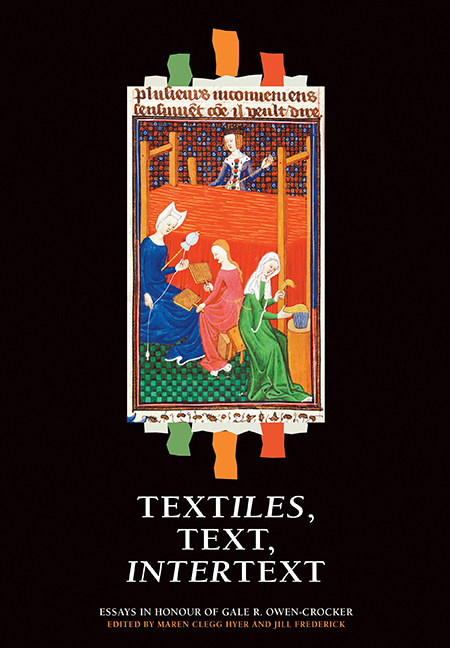Book contents
- Frontmatter
- Contents
- List of Illustrations
- List of Abbreviations
- Introduction
- A Personal Recollection
- List of publications of Gale R. Owen Crocker
- Part I Textile
- Part II Text
- Part III Intertext
- 10 Weaving Words on the Ruthwell Cross
- 11 Fates of the Apostles and Tituli
- 12 Weaving and Interweaving: The Textual Traditions of Two of Ælfric's Supplementary Homilies
- 13 Invisible Things in London, British Library, Cotton Vitellius A. xv
- 14 Redacting Harold Godwinson: The Vita Haroldi and William of Malmesbury
- Index
- Tabula Gratulatoria
12 - Weaving and Interweaving: The Textual Traditions of Two of Ælfric's Supplementary Homilies
from Part III - Intertext
Published online by Cambridge University Press: 05 July 2016
- Frontmatter
- Contents
- List of Illustrations
- List of Abbreviations
- Introduction
- A Personal Recollection
- List of publications of Gale R. Owen Crocker
- Part I Textile
- Part II Text
- Part III Intertext
- 10 Weaving Words on the Ruthwell Cross
- 11 Fates of the Apostles and Tituli
- 12 Weaving and Interweaving: The Textual Traditions of Two of Ælfric's Supplementary Homilies
- 13 Invisible Things in London, British Library, Cotton Vitellius A. xv
- 14 Redacting Harold Godwinson: The Vita Haroldi and William of Malmesbury
- Index
- Tabula Gratulatoria
Summary
Ælfric's recurrent claim to be working within a defined tradition of interpretation is one of the distinctive characteristics of his corpus of exegetical homilies. Within the homilies themselves the references are to major patristic authorities: Augustine, Gregory, and Jerome, with Gregory being the most commonly cited as the basis for Alfric's exegesis, Augustine second, and Jerome a poor third. In addition, Alfric frequently names Bede, less often than Augustine but far more often than Jerome, evidently regarding his authority as being on a par with the Church Fathers themselves, although Bede humbly defined himself merely as someone who was following in their footsteps, bringing together brief extracts from their works and adding notes of his own to clarify their sense and interpretation. His reliance on the earlier tradition was signalled directly in his Commentary on Luke and his subsequent Commentary on Mark by marginal letters denoting the authority whose words he was using at a given point. Yet, despite Bede's well-defined position as a transmitter of patristic authority, a weaver and interweaver of texts, he was regarded by the Carolingians as a Doctor of the Church, and was in practice accorded a status that associated him with the Fathers rather than with the Carolingian transmitters of that same authority, whose techniques were in fact no different from Bede's own. Alfric, in treating Bede as an authority to equal Gregory, Augustine, and Jerome, was thus firmly within a tradition defined by the Carolingians, whose texts underpinned many of the areas of intellectual achievement of the Benedictine Reform in England. Indeed, their works are major immediate sources for Alfric's homilies: the homiliary of Paul the Deacon, which is in large part an anthology of patristic lection-based homilies with the authors being identified in the rubrics; Smaragdus, whose homiliary consists mainly of homilies which are individually composed of a chain or catena of passages drawn from different authorities whose identity is signalled throughout by marginal letters, in the mode of Bede's Commentaries on Luke and Mark; and Haymo of Auxerre, whose homiliary is steeped in patristic authority, but whose method of composition is more individual, constantly echoing the words, phrases and ideas of the Fathers, but in a freer form than the anthology-compilatio of Paul or the homily-by-homily catenae of Smaragdus.
- Type
- Chapter
- Information
- Textiles, Text, IntertextEssays in Honour of Gale R. Owen-Crocker, pp. 211 - 224Publisher: Boydell & BrewerPrint publication year: 2016



